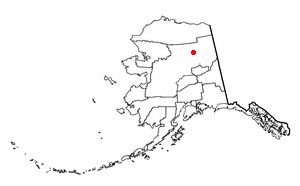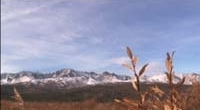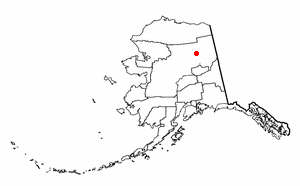
The Yukon River is a major watercourse of northwestern North America. The river's source is in British Columbia, Canada, from which it flows through the Canadian Yukon Territory. The lower half of the river lies in the U.S. state of Alaska. The river is 3,190 kilometres (1,980 mi) long and empties into the Bering Sea at the Yukon–Kuskokwim Delta. The average flow is 6,430 m3/s (227,000 ft3/s). The total drainage area is 832,700 km2 (321,500 mi2), of which 323,800 km2 (126,300 mi2) is in Canada. The total area is more than 25% larger than Texas or Alberta.

Venetie, is a census-designated place (CDP) in Yukon–Koyukuk Census Area, Alaska, United States. At the 2010 census, the population was 166, down from 202 in 2000. It includes the Village of Venetie, a Gwich'in tribal entity designated in the 1971 Alaska Native Claims Settlement Act.

Tanacross is an endangered Athabaskan language spoken by fewer than 60 people in eastern Interior Alaska.

Aklavik is a hamlet located in the Inuvik Region of the Northwest Territories, Canada. Until 1961, with a population over 1,500, the community served as the regional administrative centre for the territorial government. Building conditions at the time considered to be unsuitable resulted in the development of Inuvik 63 km (39 mi) to the east, meant to entirely replace Aklavik. However, many residents persevered and kept Aklavik as a community, with a 2016 population of nearly 600. The mayor of Aklavik is Andrew Charlie.
The Hän language is a Northern Athabaskan language spoken by the Hän Hwëch'in. Hän is spoken primarily in two places, each with their own dialect: the village of Eagle, Alaska in the United States and the town of Dawson City, Yukon Territory in Canada, though there are also Hän speakers in the nearby city of Fairbanks, Alaska.
The Inuvialuit (ɪnˈuviˌaluət) or Western Canadian Inuit are Inuit people who live in the western Canadian Arctic region. They, like all other Inuit, are descendants of the Thule who migrated eastward from Alaska. Their homeland - the Inuvialuit Settlement Region - covers the Arctic Ocean coastline area from the Alaskan border, east through the Beaufort Sea and beyond the Amundsen Gulf which includes some of the western Canadian Arctic Islands, as well as the inland community of Aklavik and part of the Yukon. The land was demarked in 1984 by the Inuvialuit Final Agreement.

The Gwichʼin are an Athabaskan-speaking First Nations people of Canada and an Alaska Native people. They live in the northwestern part of North America, mostly above the Arctic Circle.

Old Crow is a community in the Canadian Territory of Yukon, Canada. It had 221 inhabitants as of 2016, most of them belonging to the Gwichʼin-speaking Aboriginal Vuntut Gwitchin First Nation.
The Vuntut Gwitchin First Nation (VGFN) is a First Nation in the northern Yukon in Canada. Its main population centre is Old Crow. As the name indicates, the language originally spoken by the people is Gwichʼin.

Fort McPherson is a hamlet located in the Inuvik Region of the Northwest Territories, Canada. It is located on the east bank of the Peel River and is 121 km (75 mi) south of Inuvik on the Dempster Highway.
Northern Athabaskan is a geographic sub-grouping of the Athabaskan language family spoken by indigenous peoples in the northern part of North America, particularly in Alaska, the Yukon and the Northwest Territories. The Northern Athabaskan languages consist of 31 languages that can be divided into seven geographic subgroups.

The Hän, Han or Hwëch'in / Han Hwech’in are a First Nations people of Canada and an Alaska Native Athabaskan people of the United States; they are part of the Athabaskan-speaking ethnolinguistic group. Their traditional lands centered on a heavily forested area around the Upper Yukon River, Klondike River (Tr'on'Dëk), Bonanza Creek and Sixtymile River and straddling what is now the Alaska-Yukon Territory border. In later times, the Han population became centered in Dawson City, Yukon and Eagle, Alaska.
Yukon is one of Canada's three territories in the country's extreme northwest. Its history of human habitation dates back to the Ice Age, and the original inhabitants are believed to have arrived over 20,000 years ago by migrating over the land bridge from Asia. In the 18th century, Russian explorers began trade with the First Nations people along the Alaskan coast, beginning the establishment of trade relations throughout the region. The famous Klondike Gold Rush began after gold was discovered near Dawson City in 1896. As a result of the influx of people looking for gold, it was made a separate territory in 1898, split off from the Northwest Territories. The second major event in the Yukon's history is the construction of the Alaska Highway during the Second World War, for the transportation of war supplies. Eventually Whitehorse became the largest city in the Yukon, and then the capital in 1953.
Broken Slavey was a trade language used between Native Americans and whites in the Yukon area in the 19th century.

Gwichyaa Gwich’in are a Gwich'in people who live in the Yukon Flats area of Alaska, USA. This includes the Fort Yukon area on both banks of the Yukon River from Birch Creek to Porcupine River;, the Senati 65.266°N 151.183°W area of the middle Yukon River, the namesake of Sahneuti, Gwich'in chief and fur trader; and Venetie.
The Arctic Council Indigenous Peoples Secretariat (IPS) is a secretariat for the six international indigenous organizations affiliated with the eight-nation Arctic Council. The IPS does not represent indigenous peoples or their organizations, but assists those organizations in presenting their causes, and helps to disseminate information among them. IPS was established in 1994 under the auspices of the Arctic Environmental Protection Strategy (AEPS). It was around the same time that the category of Permanent Participants was being developed and applied to the three indigenous peoples’ organizations then observers in the AEPS. When the Arctic Council was established in 1996, both the Permanent Participants and IPS was reinserted into the new intergovernmental framework. Since commencing business in 1994, the role of the secretariat has been to facilitate contributions from the Permanent Participants to the cooperation of the eight Arctic states and to assist the Permanent Participants in performing, mainly communicational task.
Robert McDonald was an Anglican missionary among First Nation peoples, particularly in the northwest Arctic.

The Alaskan Athabascans, Alaskan Athabaskans, Alaskan Athapaskans are Alaska Native peoples of the Northern Athabaskan-speaking ethnolinguistic group. They are the original inhabitants of the interior of Alaska and neighboring Yukon and Northwest Territories of Canada to the east. In Alaska, where they are the oldest, there are eleven groups identified by the languages they speak.

The Tanana Athabaskans, Tanana Athabascans or Tanana Athapaskans are an Alaskan Athabaskan peoples of the Athabaskan-speaking ethnolinguistic group. They are the original inhabitants of the Tanana River drainage basin in east-central Alaska Interior, United States and a little part lived in Yukon, Canada. Tanana River Athabaskan peoples are called in Lower Tanana and Koyukon language Ten Hʉt'ænæ, in Gwich'in language Tanan Gwich'in. In Alaska, where they are the oldest, there are three or four groups identified by the languages they speak. These are the Tanana proper or Lower Tanana (Kokht'ana) and/or Middle Tanana, Tanacross or Tanana Crossing (Koxt'een), and Upper Tanana (Kohtʼiin). The Tanana Athabaskan culture is a hunter-gatherer culture and have a matrilineal system. Tanana Athabaskans were semi-nomadic and as living in semi-permanent settlements in the Tanana Valley lowlands. Traditional Athabaskan land use includes fall hunting of moose, caribou, Dall sheep, and small terrestrial animals, and also trapping. The Athabaskans did not have any formal tribal organization. Tanana Athabaskans were strictly territorial and used hunting and gathering practices in their semi-nomadic way of life and dispersed habitation patterns. Each small band of 20–40 people normally had a central winter camp with several seasonal hunting and fishing camps, and they moved cyclically, depending on the season and availability of resources.












